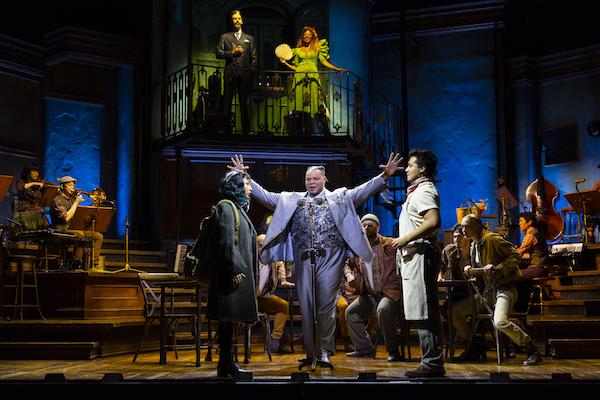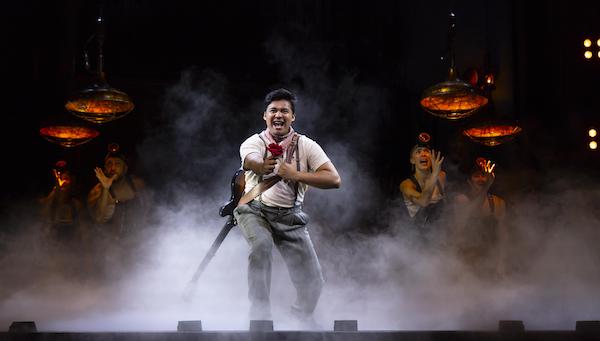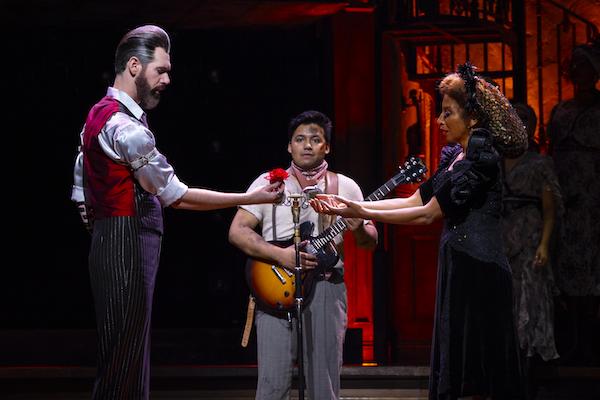Theater Review: “Springtime for Hades”
By Ezra Haber Glenn
It’s an old tale, we know how it’s going to end, but we tell it again all the same.
Hadestown Music, lyrics and book by Anaïs Mitchell. Directed by Rachel Chavkin. At Boston’s Boch Center Wang Theater through April 28. At the Shubert Theatre in New Haven, April 30 through May 5.

From top left clockwise: Matthew Patrick Quinn, Lana Gordon, J. Antonio Rodriguez, Will Mann, Amaya Braganza and company in the Hadestown North American Tour. Photo: T. Charles Erickson
It’s April in Boston. The bulbs are blooming, students are scrambling for sublets, and there are signs all around that Persephone has returned with the promise of spring: a perfect opportunity — for one week only — to catch Hadestown, the Tony-winning Broadway hit now as it passes through town.
Plenty of ink has been spread praising this show. (You don’t get eight Tonys for being a sleeper…) This critical attention is well deserved, given how much there is to celebrate. New England hometown hero Anaïs Mitchell has crafted a honky-tonk-folk fusion of Greek myths (combining two classics: “Orpheus and Eurydice” meets “Hades and Persephone”) with a decidedly “late-stage Capitalism” environmental parable. Rachel Chavkin’s (Natasha, Pierre, & The Great Comet of 1812) innovative staging makes bold and efficient use of space, motion, lighting, and set design. There’s the clever blending of Depression-Era style with Trump-Era political overtones and a rotating cast of actors breathing new life and eternal pathos into these millennia-old characters.
While some of the most spectacular aspects may require a pilgrimage to Broadway, where the show can get into a more steady groove and really spread its wings, the touring edition delivers all the look, the feel, the boom, and the sizzle of the original and it places a well-deserved spotlight on a great cast. The production also allows more of us provincial bumpkins to appreciate this rich material on stage, as opposed to only knowing the Grammy-winning album. (And trust me, the staging adds a lot of additional depth to this fable: the dancing is nothing special, but there is some really meaningful movement here…)
Principals and supporting cast alike are strong, which is particularly important for this show: part of Mitchell’s genius was gifting nearly every performer with a fully formed role and a range of emotion with room for development. There are no “props with mouths” in this one. Complex characters deserve powerful performers (and vice versa), and it’s a joy to see them come together and begin to interact. (Full disclosure: the one character I’ve never felt to be fully realized in the book is, sadly, Orpheus himself, who always comes across as something of a putz. J. Antonio Rodriguez plays him as well as possible, emphasizing the “optimist dreamer” elements: a putz, but at least he’s a sweet, dreamy, little-boy-lost putz.)
In particular, former understudy Will Mann takes the role of Hermes and makes it his own, with strong (if not always clear) vocals and confident stage presence. The character serves as a dramatic linchpin: a guide, narrator, and master of ceremonies rolled into one. Even more challenging, this mere mortal needs to convince us that he’s a spry messenger god capable of dancing with winged feet. This is not an easy act to sell given Mann’s rather large, resonant frame, but he’s surprisingly light, redefining the concept of “amazing grace.” (I once saw a delightful old video of Jackie Gleason dancing, and Mann channels some of this same impish agility.)

J. Antonio Rodriguez and company in Hadestown North American Tour. Photo: T. Charles Erickson
Our other guides on this path, the three fates (Marla Louissaint, Lizzie Markson, Hannah Schreer), are talented enough to bring on the magic when needed. Even better, for a show we came to see as well as hear, they weave their spells throughout many of the numbers, spinning threads of destiny with arms, hips, shoulders, and legs into a fluid and beautiful full-body web of tragedy.
Down below (or brooding in the background: the staging puts full cast in view nearly the whole time), Hades (Matthew Patrick Quinn) controls the show, alternating between the growl of slow-rolling thunder and the commanding boom of the Undisputed Ruler of the Underworld. Quinn’s bio notes that he “originated several villainous roles for Disney Cruise Lines,” and it shows: he’s a fun blend of Vincent Price and Bull from Night Court. He sings like a wolf who has gargled with honey. It sounds corny, but it works — and Quinn knows how to tone it down when needed in order to ride the emotional currents Mitchell has laid down.
Hades is well balanced by Persephone, the Goddess of Spring, cruelly trapped in the Underworld, drowning her sorrows in the fruit of the vine. Lana Gordon (the only lead from the Broadway cast) gets it just right: she’s boozy without being buffoonish, brash but not annoying. And when she needs to, she can really sing. (It’s too bad the show doesn’t include more complex dance numbers, to make full use of her range; Gordon began her stage career with Alvin Ailey.)
Eurydice (Amaya Braganza) is at turns spirited and soulful, an anime pixie navigating a cold and cruel world. The vocals are particularly challenging for this part — some numbers, many originally sung by Mitchell in early workshopped recordings, present a real puzzle. Mitchell is known for having a young, almost childlike voice — overdo that approach and baby talk or mockery might result. Braganza threads the needle, kneading in enough poise and petulance to remove the sap but keep the sweet.
The “Workers Chorus” gives a triple meaning to its name: in addition to being double-cast as proletariat laborers in the world above and a drone workforce for Hades down below, these players also move the show — and much of the scenery — constantly reconfiguring the staging and lighting, while dancing and carrying a tune.
The staging is tight (in both senses: smart, precise, and so well coordinated — but it is also a small stage). The spotlight could use a bit more practice (maybe it will improve later in the week?). That said, so much of the lighting is cleverly included as part of the stage elements that the show masterfully delivers everything from shadows and candlelight to the full-frontal attack of Hades’s powerful ELECTRIC CITY!

Matthew Patrick Quinn, J. Antonio Rodriguez, and Lana Gordon in Hadestown North American Tour. Photo: T. Charles-Erickson
At times the sound mix seemed to struggle a bit to balance voices with full chorus, but the on-stage, largely acoustic musicians were phenomenal, prompting more applause than we usually hear for “accompaniment.” Emily Frederickson on trombone and Michiko Egger on guitar were particular standouts among a well-tuned ensemble.
One of the key themes that pulls all of Hadestown together is the notion of recurring patterns, and the ways they play with our expectations and disappointments: warm summer sun fades into cold winter as Persephone disappears into the underworld. But Spring promises a new beginning; the blossoms stir new hope, though they also contain the kernel of loss and death. Like junkies ever-jonesing for life’s highs and lows, we keep coming back to do it again. The play closes with a poignant mediation on these cycles, applied to both tragedy and theater. It’s an old tale, we know how it’s going to end, but we tell it again all the same. Summoning that last drop of optimism — daring to imagine that maybe, just maybe, this time will be different — is what gives us all the courage to live another day, to face the music and continue to roll the stone uphill. Hope springs eternal, which may be foolish, but it also may be just what we need these days.
Ezra Haber Glenn is a Lecturer in MIT’s Department of Urban Studies & Planning, where he teaches a special subject on “The City in Film.” His essays, criticism, and reviews have been published in the Arts Fuse, CityLab, the Journal of the American Planning Association, Bright Lights Film Journal, WBUR’s ARTery, Experience Magazine, the New York Observer, and Next City. He is the regular film reviewer for Planning magazine, and member of the Boston Society of Film Critics. Follow him here.
Tagged: Amaya Braganza, Anaïs Mitchell, Hadestown, J. Antonio Rodriguez, Lana Gordon, Matthew Patrick Quinn, Rachel Chavkin
